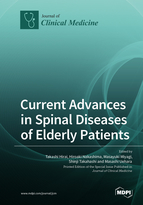Current Advances in Spinal Diseases of Elderly Patients
A special issue of Journal of Clinical Medicine (ISSN 2077-0383). This special issue belongs to the section "Orthopedics".
Deadline for manuscript submissions: closed (15 December 2021) | Viewed by 56956
Special Issue Editors
Interests: spine surgery; cervical spine; pain; spinal cord
Interests: spinal deformity; cervical myelopathy; minimally invasive surgery
Interests: spinal deformity; osteoporosis; intervertebral disc; pediatric spine surgery
Interests: osteoporosis; spine surgery; vertebral fracture; spinal alignment; adult spinal deformity
Special Issues, Collections and Topics in MDPI journals
Special Issue Information
Dear Colleagues,
Spine-related disorders often impair quality of life and activities of daily living, and are problems in rapidly aging societies. Notably, motor deficit, body imbalance, and neuropathic pain have been recognized as the main causes of frailty in the elderly population. Spine surgeons and neurosurgeons should make appropriate diagnoses, to interpret detailed pathologies, and plan optimized solutions in treating such patients.
For this Special Issue titled “Current Advances in Spinal Diseases of Elderly patients”, we would like to invite authors to submit their original articles or review papers on recent surgical innovations, new diagnostic developments, and the long-term perspective of the clinical treatment of spinal disorders. Notably, we would like to focus on strategies for metastasis, degenerative deformity, and inflammatory diseases in the spine. In addition, this Special Issue welcomes studies regarding refractory spinal disorders such as ankylosing spine caused by ossification of spinal ligaments or autoimmune diseases as well. We hope this Issue will bring about academic cooperation for enlightenment in the field of spine and spinal cord disorders.
Dr. Takashi Hirai
Dr. Hiroaki Nakashima
Dr. Masayuki Miyagi
Dr. Shinji Takahashi
Dr. Masashi Uehara
Guest Editors
Manuscript Submission Information
Manuscripts should be submitted online at www.mdpi.com by registering and logging in to this website. Once you are registered, click here to go to the submission form. Manuscripts can be submitted until the deadline. All submissions that pass pre-check are peer-reviewed. Accepted papers will be published continuously in the journal (as soon as accepted) and will be listed together on the special issue website. Research articles, review articles as well as short communications are invited. For planned papers, a title and short abstract (about 100 words) can be sent to the Editorial Office for announcement on this website.
Submitted manuscripts should not have been published previously, nor be under consideration for publication elsewhere (except conference proceedings papers). All manuscripts are thoroughly refereed through a single-blind peer-review process. A guide for authors and other relevant information for submission of manuscripts is available on the Instructions for Authors page. Journal of Clinical Medicine is an international peer-reviewed open access semimonthly journal published by MDPI.
Please visit the Instructions for Authors page before submitting a manuscript. The Article Processing Charge (APC) for publication in this open access journal is 2600 CHF (Swiss Francs). Submitted papers should be well formatted and use good English. Authors may use MDPI's English editing service prior to publication or during author revisions.
Keywords
- inflammatory spinal disorders
- ossification of spinal ligaments
- degenerative adult deformity
- spinal metastasis
- osteoporosis
- osteoporotic vertebral compression fracture
- surgical treatments







